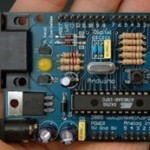We were at the park the other day and I noticed how only a few of the words stood out on the swings creating an interesting phrase.


 This is an update to my first post about connecting a stepper motor to an Arduino or other microcontroller.
This is an update to my first post about connecting a stepper motor to an Arduino or other microcontroller.
 This is my first (and so far last) expedition in to the world of pepper beers. I had tried some other pepper beers and loved them, and I generally like spicy food, so I thought I would give it a go. It was an interesting experiment and I learned some valuable lessons from it. Continue reading →
This is my first (and so far last) expedition in to the world of pepper beers. I had tried some other pepper beers and loved them, and I generally like spicy food, so I thought I would give it a go. It was an interesting experiment and I learned some valuable lessons from it. Continue reading →
 After building a mash tun and running my first batch of beer through it, I realized very quickly that trying to stir the mash with a kitchen spoon is not an easy task. There are many types of paddles available to buy online, but in the spirit of homebrew DIY and not wanting to spend much money, I decided to make my own.
After building a mash tun and running my first batch of beer through it, I realized very quickly that trying to stir the mash with a kitchen spoon is not an easy task. There are many types of paddles available to buy online, but in the spirit of homebrew DIY and not wanting to spend much money, I decided to make my own.
 Here is how I converted a cooler (ice chest) into a mash tun (MLT?). For those of you new to home brewing, a mash tun is used for converting starches in the grain to sugar which later is turned into alcohol by the yeast. You mix the crushed grain (mostly barley) with warm water, hold it at a specific temperature for a while (that’s where the insulated cooler comes in) then drain the liquid (wort) out leaving the grain behind. Then you proceed to boiling the wort while adding hops and other additions (the rest of the brewing process).
Here is how I converted a cooler (ice chest) into a mash tun (MLT?). For those of you new to home brewing, a mash tun is used for converting starches in the grain to sugar which later is turned into alcohol by the yeast. You mix the crushed grain (mostly barley) with warm water, hold it at a specific temperature for a while (that’s where the insulated cooler comes in) then drain the liquid (wort) out leaving the grain behind. Then you proceed to boiling the wort while adding hops and other additions (the rest of the brewing process).
I like raspberries, and I like wheat beer. I also like brewing beer, so it was inevitable that the two should someday meet.
Here’s a quick and easy way to label homebrew beer bottles. I take some small printer labels and print the name of the beer on them and stick them to the caps. You could also print other info like bottling date or gravity. I like this method since there is nothing to clean off when you recycle the bottles. You just throw away the label with the cap. It also makes it easier to tell the difference without taking them out of the box.